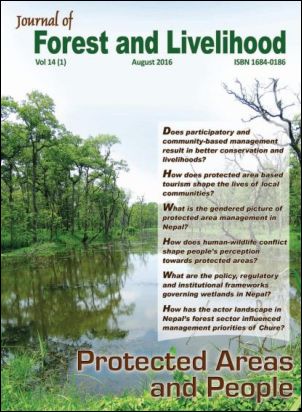Human-Rhino Conflict: Local People’s Adaptation to Impacts of Rhino
DOI:
https://doi.org/10.3126/jfl.v14i1.23162Keywords:
Adaptation, buffer zone, Chitwan National Park, human-wildlife conflict, one horned rhinocerosAbstract
The greater one-horned rhinoceros, a protected species, significant to growing eco-tourism industry and conservation efforts in Nepal poses a number of challenges to the local people residing in the vicinity of the Chitwan National Park (CNP). The article is based on a study of local people’s perceptions on impacts of rhino and various coping and adaptation measures being adopted by them. The study also aims to explore ways to enhance adaptation by securing local people’s participation in rhino conservation. Review of secondary literature, surveys, Focus Group Discussions (FGDs), and Likert scale analysis were carried out for the purpose of the study. Five per cent of the households (50) in Bachauli Village Development Committee that hosts Bagmara Buffer Zone Community Forest User Group of the CNP were randomly selected. The study found that despite 80 per cent of the respondents incurred damage in some form from rhinos, 40 per cent of them exhibited a positive perception towards rhino conservation. Among several coping and adaptive measures to damages, a combination of electric/solar fencing and trench is found to be most effective. Applied research through collaborations between social scientists and ecologists can help to address the gaps in the understanding of different elements of human-wildlife conflict.
Downloads
Downloads
Published
How to Cite
Issue
Section
License
CC-BY-NC: This license allows reusers to distribute, remix, adapt, and build upon the material in any medium or format for noncommercial purposes only, and only so long as attribution is given to the creator.





